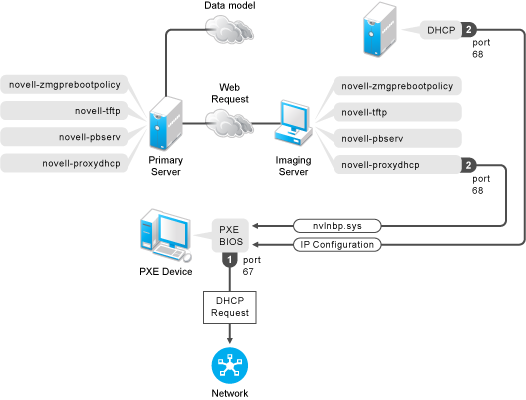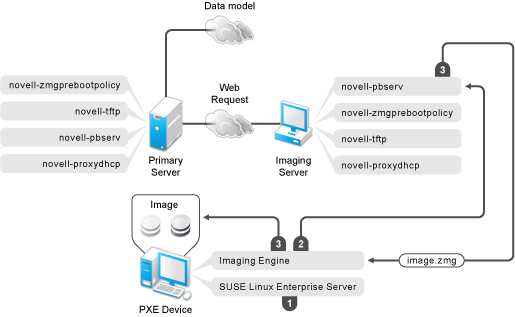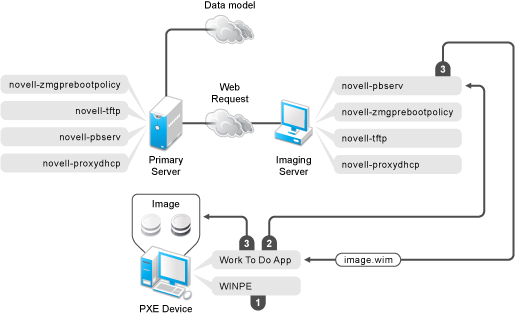2.2 Preparing a Satellite with the Imaging Role
A Satellite is a managed device that can perform certain roles that a ZENworks Primary Server normally performs. A Satellite can be any managed device (server or workstation). When you configure a Satellite, you specify which roles it performs (Imaging, Collection, or Content). A Satellite can also perform roles that might be added by third-party products that are snap-ins to the ZENworks framework.
The following sections provide detailed information:
2.2.1 Understanding the Imaging Role
The Imaging role installs the Imaging services and adds the Imaging role to the device. The Satellite with the Imaging role is called Imaging Satellite. The Imaging Satellite requires both Proxy DHCP and DNS server to be running in the Imaging environment.
The Imaging roles allows you to:
-
Perform all the Imaging operations on the device by using it as an Imaging server. The operations includes taking an image and applying an image within as well as across subnets by using unicast or multicast imaging.
-
Achieve load balance for the Primary Server.
-
Replicate TFTP folder and add-on images from Primary Server to Satellite Server.
The Satellite communicates with the Primary Server for the Imaging operations.
On the managed device, the Imaging module is inactive until you promote the managed device to be a Satellite with the Imaging role or the Imaging role is added to an existing Satellite. This activates the Imaging services on the device, and enables you to perform the Imaging operations in auto and maintenance mode.
The Imaging components installed on the device include Novell ZENworks PXE Client Files, Novell ZENworks PXE Update Files, and Novell ZENworks Multicast Application (zmgmcast).The Imaging services installed on the device include Novell TFTP, ZENworks Preboot Policy (zmgpbpolicy), ZENworks Preboot (pbserv), and Novell Proxy DHCP. All services, except for proxy DHCP, are automatically started. You can start or stop the proxy DHCP service from ZENworks Control Center.
2.2.2 Configuring the Imaging Role to the Satellite
You can configure the Imaging role to the Satellite by using ZENworks Control Center or the zman command line utility.
To configure the Imaging role by using the zman command line utility, see Satellite Server Commands
in the ZENworks Command Line Utilities Reference.
2.2.3 Illustrating the Preboot Services Processes on the Imaging Satellite
A typical Preboot Services operation for Imaging Satellite flows as follows:
-
A Preboot bundle is created in ZENworks Control Center and assigned to a PXE-enabled device.
-
The PXE-enabled device starts to boot.
-
The device sends a DHCP discovery request to determine the IP address of the Imaging Satellite.
-
The DHCP server responds with an IP address for the device to use.
-
Novell-proxydhcp responds with the IP addresses of the TFTP server, as well as the filename of the Preboot Services bootstrap program (nvlnbp.sys or nvlnbpx64.efi).
-
The PXE device downloads the Preboot Services bootstrap program by using novell-tftp on Imaging Satellite.
-
After the Preboot Services bootstrap program is downloaded and executed, the device checks for the novell-zmgprebootpolicy on Imaging Satellite to see if there is any imaging work to do.
-
If there is imaging work to do (as contained in a Preboot bundle that is assigned to the device), the device downloads the WinPE environment from the server.
-
Any imaging tasks contained in the Preboot bundle are performed.
-
If there are no imaging tasks to perform, files are not downloaded and the device proceeds to boot to its operating system.
All database transactions for assigned imaging tasks are performed through a web request from the Imaging Satellite to the Primary Server.
The following sections explain how the Preboot Services work for PXE boot, ZENworks Imaging, and third-party imaging on the Imaging Satellite:
Illustrating the Preboot Services Process for PXE Boot on the Imaging Satellite
The following example assumes that the devices and Imaging Servers are in the same network segment.
Figure 2-1 Preboot Services Process for PXE Boot on the Imaging Satellite

Processes:
-
When the device boots, the PXE BIOS issues a DHCP request with PXE extensions. The request is broadcast on port 67.
-
The DHCP server responds with IP configuration information on port 68, and the Proxy DHCP server on Imaging Satellite responds on port 68 with the name of the bootstrap program (nvlnbp.sys or nvlnbpx64.efi) and the IP address of the TFTP service or daemon where it can be found.
Illustrating the Preboot Services Process for ZENworks Imaging on the Imaging Satellite
The following example assumes that the devices and Imaging Servers are in the same network segment.
Figure 2-2 Preboot Services Process for ZENworks Imaging on the Imaging Satellite

Processes:
-
SUSE Linux Enterprise Server (SLES) is loaded and run on the device.
-
The ZENworks Imaging Engine (img) requests the assigned Preboot Services work details and performs the work.
-
The image is laid down on the device and it automatically reboots.
Illustrating the Preboot Services Process for Third-Party Imaging on the Imaging Satellite
For ZENworks Third-Party imaging, you must upload the third-party tools on the Primary Server. For more information, see Section C.3, Performing ZENworks Third-Party Imaging by Using ZENworks Control Center. This automatically replicates the required imaging distro and tools from the Primary Server to the corresponding tftp directory on the Imaging Satellite. The imaging process on the Imaging Satellite is similar to the process on the Primary Server. For more information on the imaging process on the Primary Server, see, Section 1.5, The Preboot Services Processes.
The following example assumes that the devices and Imaging Servers are in the same network segment.
Figure 2-3 Preboot Services Process for Third-Party Imaging on the Imaging Satellite

Processes:
-
WinPE is loaded and run on the device.
-
The ZENworks Work To Do (ZENworks Third-Party Imaging) application requests the assigned Preboot Services work details and launches corresponding third-party Imaging engine to perform the work.
-
The image is laid down on the device and it automatically reboots.